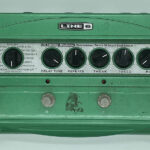In the annals of rock history, and particularly within the realm of guitar playing, true revolution is often attributed to a select few. Among these luminaries stands Edward Van Halen, a singular force whose groundbreaking contributions redefined the electric guitar’s potential. His innovative techniques and dazzling abilities were nothing short of transformative, reshaping the landscape of guitar music forever. It all began with a vision, a need, and a now-iconic instrument known to fans worldwide as the Frankenstrat Guitar.
Image alt text: Eddie Van Halen smiling and playing his iconic black and white striped Frankenstrat guitar on stage, showcasing his revolutionary guitar style.
When Van Halen burst onto the music scene in the late 1970s, he ignited a seismic shift in rock guitar. Seemingly overnight, he discarded the existing rulebook, forging a new path that few had dared to imagine. Guitarists worldwide were left astounded, questioning, “How did he achieve those sounds? What was that strange, striped guitar he was playing?” This was a revelation: a raw, energetic rock band hailing from Los Angeles, fronted by a youthful, grinning guitar virtuoso whose musical ferocity was simply undeniable. To truly grasp the magnitude of the shockwaves he sent through the guitar world, one must journey back to that pivotal era.
Before February 10, 1978, the release date of Van Halen’s self-titled debut album, rock guitarists were contentedly navigating familiar pentatonic scales on readily available, mainstream electric guitars. Then, Van Halen dropped, and the guitar world was irrevocably altered. You either embraced this electrifying new direction, or risked being left behind.
Eddie Van Halen was unlike anything anyone had witnessed or heard before. His technique was mesmerizing, his sound unprecedented, and the guitar he wielded was an enigma. This striking black and white striped instrument became his weapon of choice as he unleashed a dazzling torrent of sounds – swoops, dives, screams, and blazing runs – across one of the most original and celebrated debut albums in history. Remarkably, this sonic onslaught was achieved with no overdubs, no elaborate pedalboards, and no expensive custom gear. Those fortunate enough to witness Van Halen’s early club performances on the Sunset Strip had a glimpse of the coming storm, as he routinely reduced venues to smoldering ruins with his guitar prowess. While some established guitar heroes initially scoffed at his seemingly makeshift, duct-taped stage setup, their laughter quickly faded as Eddie consistently stole the show, leaving audiences utterly speechless.
Image alt text: Close-up shot of Eddie Van Halen intensely performing on his black and white striped Frankenstrat guitar, highlighting his dynamic stage presence and innovative playing style.
His technique was not just sonically groundbreaking; it was visually captivating. His acrobatic stage presence was riveting, but to mistake it for mere showmanship was to miss the essence of his playing. Eddie’s imitators, and there were many, failed to grasp this fundamental truth. Everything he did with his guitar, every dazzling run, every innovative technique, served the song. His playing was always in service of crafting great music, delivered with grace, taste, and unwavering musicianship. This is evidenced by his string of hit after hit: “Jamie’s Cryin’,” “You Really Got Me,” “Dance the Night Away,” “Beautiful Girls,” and countless more.
Eddie Van Halen wasn’t merely at the center of the rock guitar revolution; he was the revolution. Ironically, away from the stage, he was a thoughtful and unassuming individual. While Van Halen the band exuded confidence and swagger, it was always delivered with a sense of fun and lightheartedness. Unlike many of their contemporaries, Van Halen was not steeped in darkness or brooding intensity. Eddie Van Halen was always smiling, clearly relishing every moment of blowing audiences away with his phenomenal talent, making it all look, and sound, incredibly fun.
The Birth of an Icon: A New Take on a Classic Guitar
Examine the cover of Van Halen’s debut album. Focus on the guitar: the black and white (later red) striped instrument brandished by a 22-year-old Eddie Van Halen, presented to the world as a glimpse into the future of guitar. This instrument rapidly ascended to iconic status, becoming perhaps the most instantly recognizable guitar globally. At the time of the album’s release, no one had ever encountered a guitar quite like it, because it simply didn’t exist. This wasn’t an off-the-shelf model; it was something entirely new.
Image alt text: Eddie Van Halen holding his black and white Frankenstrat guitar on the cover of Van Halen’s debut album, showcasing the iconic instrument that revolutionized rock guitar.
Eddie Van Halen built it himself. He possessed not only the mind of a musical genius but also that of an inventive tinkerer, constantly experimenting with his gear, pushing boundaries, sometimes destroying equipment in pursuit of sounds that were simply unavailable in any guitar store. No commercially available guitar could meet the demands of his groundbreaking playing style. He had experimented with standard models in his early years but found them consistently lacking. Thus, he took matters into his own hands.
Ironically, Eddie wasn’t a guitar tech in the traditional sense. He lacked formal knowledge of wiring or guitar design. His genius lay in his resourcefulness, creativity, and innovative spirit. Unburdened by tradition and unaware of conventional rules, he forged his own path. During the period before he became a household name, this freedom allowed him to gather parts and refine his vision for a truly unique instrument.
The result was extraordinary. The guitar gracing the cover of Van Halen was Eddie’s original “super guitar.” He acquired a factory-second guitar body for a mere $50 and a neck for $80, both dating back to 1975. The body was pre-routed for three single-coil pickups, but Eddie’s vision demanded more. Armed with a chisel and soldering iron, he installed a powerful humbucking pickup from an older semi-hollow body guitar, rotating it slightly to accommodate the wider string spacing of the vintage Fender bridge.
Image alt text: Close-up view of the body of Eddie Van Halen’s Frankenstrat guitar, highlighting the distinctive striped paint job, humbucker pickup, and modifications.
In a stroke of accidental brilliance born from necessity, Eddie devised a method to combat feedback: he submerged the humbucking pickup in a Yuban coffee can filled with molten paraffin wax, a technique now known as “potting” pickups. He also modified the vibrato bridge plate to rest flush against the body, disabling upward bends but enhancing tuning stability. Preferring a wider and flatter neck profile, Eddie replaced the original frets with larger fret wire.
This guitar body became the canvas for the now-iconic striped paint job, applied using black and white Schwinn® acrylic lacquer bicycle paint. He fashioned a homemade black pickguard, concealing the neck and middle pickup cavities, and installed a single master volume knob (famously labeled “Tone”), a brass nut, and a vintage Fender tremolo tailpiece.
Despite its rapid construction and minimal cost (under $150), this unassuming instrument was poised to revolutionize the guitar world. It was on this guitar that Eddie recorded “Eruption,” creating timeless music that would inspire generations. The Frankenstrat guitar became Van Halen’s primary instrument for his initial albums and tours. He later added a red top coat to the striped finish, along with orange and red truck reflectors, completing the visual transformation into one of rock and roll’s most recognizable guitars.
During Van Halen’s second world tour, he replaced the original tremolo with a prototype locking tremolo system designed by Floyd Rose. To bridge the gap between the guitar body and the tremolo plate, Eddie ingeniously used a quarter as a shim. Following a neck breakage, subsequent replacement necks all featured Schaller® tuners, a feature he retained.
Fans were captivated by the guitar and Eddie’s extraordinary playing. They affectionately nicknamed it “Frankenstein™.” It’s important to note that Eddie himself never used this name; it was bestowed upon the guitar by his devoted fanbase. Rarely has a guitar become so iconic that fans themselves christened it. For Eddie, it was simply, “My baby.”
From DIY to Replicated Dream: The Frankenstrat Legacy Continues
Eddie Van Halen, a true innovator, was in a constant state of evolution. His style, sound, and gear evolved alongside his musical journey. Comparing 1978’s Van Halen to 1995’s Balance, or “Ain’t Talkin’ ’Bout Love” to “Right Now,” reveals a continuous progression. His playing remained phenomenal, but his artistry, musicianship, and songwriting matured and deepened with each groundbreaking record and tour.
Eventually, Eddie sought to share his legacy of innovation with guitarists worldwide. He aimed to create a top-tier replica of his original Frankenstrat guitar, a faithful recreation of the instrument that had become a monumental and unmistakable icon. Having collaborated on various projects with different manufacturers previously, Eddie knew that for a truly authentic recreation of the “Frankenstein™” guitar, there was only one company he could partner with: Fender.
The collaboration was a natural fit – a meeting of two pioneering forces. An artist joining forces with a company renowned for its history and tradition of innovation. In 2007, Eddie Van Halen and the master builders at the Fender Custom Shop in Corona, California, joined forces to launch the EVH® brand, encompassing guitars, amps, and musical products. The inaugural offering was a highly anticipated musical milestone: a limited edition run of 300 meticulously crafted Eddie Van Halen Frankenstein™ replica guitars – astonishingly accurate renditions of what is widely considered the world’s most recognizable electric guitar.
This replica, with its red, black, and white striped ash body and bolt-on maple neck, underwent an extensive aging process to mirror the wear and tear of Eddie’s years of relentless touring with the original. No detail was overlooked in replicating every scratch, ding, and cigarette burn. Fender’s artisans even meticulously sourced 1971 quarters – the correct year – just like the one Eddie had once used as a shim under the original tremolo bridge. While Eddie no longer employed the quarter for that purpose, it remained a defining visual element of the guitar, included on both his personal instrument and every Frankenstrat guitar replica.
The replica also featured a Seymour Duncan® Custom Shop EVH® humbucking pickup, a single master volume knob (labeled “Tone”) on a single-ply partial black pickguard, mirroring the original. Other authentic details included Schaller® tuners, aged chrome hardware, and a limited edition, fully “relic-ed” EVH® road case. With meticulous attention to detail, the guitar even incorporated a non-functional three-way switch and single-coil pickup in two of the pickup routs.
The Frankenstein™ Replica Tribute model is more than just a guitar; it’s a phenomenally crafted piece of rock history, a testament to guitar innovation, and a re-evocation of the awe and excitement experienced when Eddie Van Halen first unleashed his incredible musical power. Ultimately, it remains, and always will be, his baby.


